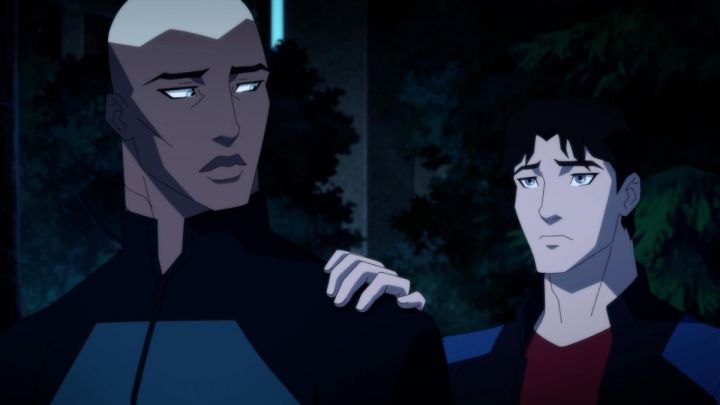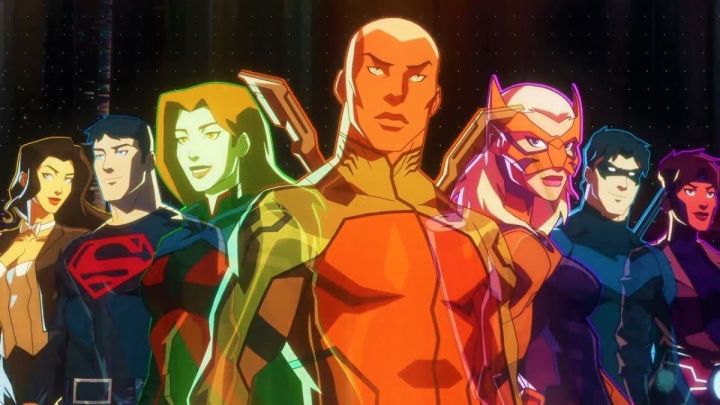Young Justice: Phantoms debuted its last episode, Death and Rebirth, on June 9, bringing its long-awaited fourth season to a close with a wedding and an episode that truly felt like the end of an era. Whether you loved or hated the season — and many fans seem firmly set in one extreme or the other, no in-betweens –, the fact remains that Young Justice is the superior animated show right now. No other series currently airing comes close in terms of quality and fan service (OK, maybe Harley Quinn), whether because they don’t want to or because they don’t care to try. This season continued the series’ commitment to exploring timely topics that reflect our reality while still delivering on the action and adventure fans have come to expect.
Still, not everything was perfect. Like most other worthwhile shows, Young Justice struggles to balance its shameless ambition with its execution, and the last three arcs of the season are the perfect proof. Young Justice does many things right, but in trying to cover so much ground, it can’t help but sacrifice characters and themes to its own detriment. Phantoms felt hectic and unfocused at times, jumping from one storyline to the next without providing a satisfying payoff.
The creative minds behind the show are seemingly playing the long game, and fans can’t expect them to tie every loose end in a neat bow; Young Justice has never done that, nor should it. There will always be unfulfilled promises and payoffs that take episodes, seasons, and even years to arrive. However, with the show’s future in doubt — HBO Max remains tight-lipped about a potential fifth season, and co-creator and exec producer Greg Weisman has been very vocal about the show’s uncertain fate — and a slew of characters who were neglected throughout the season, can we in good faith call Phantoms a success? Was the season worth the three-year wait?
The strongest of starts

Young Justice: Phantoms started strong, introducing its “arc” approach by presenting a self-contained storyline starring Miss Martian, Superboy, and Beast Boy. Spread across four episodes, the plot concerns Conner and M’Gann’s trip to Mars in preparation for their upcoming nuptials. The arc revisited the Mars storyline that began as early as season 1 by bringing back M’Gann’s evil brother, Ma’alefa’ak, and going deeper than ever into the racial conflict between Green and White Martians.
The show’s social commentary was clumsy at times, but its intention was clear and honest. Above all, it never felt like preaching; Young Justice has always found a way to seamlessly integrate race issues into its larger story, and the Mars plot is perfect proof. By intertwining them with M’Gann and Conner’s relationship, Phantoms successfully built a socially conscious story that never feels unnecessary or gratuitous. The arc ends with Conner’s apparent death (it’s later revealed he was trapped in the Phantom Zone), opening the door for what is, objectively speaking, the best arc in the season.
In terms of execution, Artemis’ four-episode arc is Phantoms‘ crowning achievement. The storyline deals with Artemis’ lingering issues with her estranged sister, Jade, while exploring themes of grief, family, duty, and legacy. In just four episodes, Young Justice provides a satisfying conclusion for Artemis and Jade’s storyline, which began in season 1, and sets up the next chapter in their journey, leaving things open-ended without feeling incomplete. Artemis’ arc is Young Justice at its best, showcasing its strengths — emotionally resonant storytelling, high stakes, unparalleled character development, elegant animation, thrilling action — in service of a poignant narrative that uses its characters to their fullest extent.
Artemis’ arc features a carousel of fan-favorite returning characters — Will, Roy, Orphan, Barbara, Lady Shiva, Cassandra Savage, Ra’s al Ghul, Sensei, Jason — and uses them intelligently, allowing them a chance to shine without ever pulling focus, thus creating the season’s best dynamic. The arc’s use of literary references was also a stroke of genius, adding unexpected depth to its compelling central character. Artemis has long been one of the most complex and layered figures in Young Justice, and her arc in Phantoms cements her as arguably the show’s best character.
With its first two chapters, Phantoms reminded audiences why it’s such a fascinating show. It found new layers to its already three-dimensional characters, exploring new facets of their stories while still moving the cogs of its larger storytelling machine. Few animated shows — indeed, few shows come close to the level of detail and understanding of their characters that Young Justice has. The Artemis/Jade and Conner/M’Gann’s relationships are perfect examples of the rich narrative that the show excels at, exploring deeply humane and relatable themes without becoming an after-school special. The heights these two arcs reached were unparalleled, but they only made what came next all the more jarring.
Nothing lasts forever

Unfortunately, Zatanna’s arc began showing signs of the same weakness that would plague the second half of the season. By shifting focus from richly personal stories full of gravitas to long-term and massive worldbuilding, Phantoms betrayed its initial setup. Zatanna and Kaldur’s arcs sidelined them, showing more interest in the antagonists and supporting players. Klarion, Fate, and Child stole the attention from Zatanna, and Aquaman was arguably the lead in Kaldur’s episodes. The choice seems all the more insulting considering Zatanna and Kaldur were two of the show’s most prominent characters in season 1 and became less prominent in seasons 2 and 3. Phantoms was their chance to come back to the spotlight. To see them outshined in their own stories was disappointing.
Still, at least Zatanna and Kaldur received some character development. Rocket, a familiar character who was never quite a lead before, received an arc of her own, but it was hers in name only. Playing what can only be described as a supporting role in a story about everything but her, Rocket’s episodes focused on everything from the New Gods to Lor-Zod, even finding time to give Forager a love story. Yet, Rocket remained benched, with the show only providing minimal development to her story.
It’s unbelievable that the show failed Rocket so astoundingly; we’re talking about a Black woman co-parenting her autistic child while trying to live up to her role as a Justice League member. The storylines literally write themselves, and the fact Phantoms chose to focus on Forager, of all characters, goes beyond the bizarre.
Great expectations

Calling Dick Grayson the lead of Young Justice might be a reach, but the character’s popularity and importance to the show’s success are undeniable. Dick acted as the de facto lead of seasons 2 and 3; logically, many expected him to play a prominent role in Phantoms, and his arc coming last also hinted at his importance. Alas, the powers behind Young Justice had other plans.
To say Dick got sidelined would be an understatement. He spoke only a handful of times throughout his five episodes, had no character development, and served mainly as a plot device to bring the team back together. Indeed, the last five episodes were all about Superboy, whose prolonged stay in the Phantom Zone framed the season’s main storyline. It makes sense that Superboy would play a crucial role in Phantoms; he is an incredible character in his own right, received valuable development during his arc, and is weighty enough to support an entire season around him — plus, it’s always a delight to hear Nolan North. But does his development matter more than Dick’s or Raquel’s? The show seemed to think so.
Showcasing Superboy is a perfectly valid choice, and no fan would’ve complained; he deserves the spotlight. But Phantoms initially offered something different, a promise of individual arcs centered around each of the show’s main characters. It delivered marvelously with Superboy, M’Gann, and Artemis, but failed with all others; there’s no other way to put it.
It’s not like the finished product was bad. On the contrary, the Zod storyline was powerful — a tad clichéd, but Zod is an inherently clichéd character in most of his adaptations. Once one comes to terms with what is and lets go of what could’ve been, Phantoms is another piece of enthralling, energetic, and driven television, continuing Young Justice‘s efforts to push the boundaries of what an animated show can and should be. But after a three-year absence and many unfulfilled promises, the result tasted more bittersweet than ever.
Schrödinger’s Young Justice

As of now, Young Justice is in the same spot it kept Superboy in for most of the season. Not quite dead, not exactly alive, the show exists in a state of stasis until HBO decides its ultimate fate. If this is indeed its last hurrah, it’s one hell of a way to go. The last episode finally featured the wedding of M’Gann and Conner, reuniting its vast and mostly silent cast under one roof in a celebration for both the couple and the fans. The creators behind the show have been open about their never-ending approach to the show; in their minds, Earth-16 is an unstopping, ever-evolving force. Thus, Young Justice will never have a proper ending. So why does Death and Rebirth feel so much like the end of a book, not just a chapter?
The verdict is in for Young Justice: Phantoms, and it’s more divisive than ever. It’s frustrating for what could’ve been, but remarkable for what it is. Young Justice is a show that lives and dies by its word. Fans come to it expecting a more mature and cohesive narrative that still honors its source material, and Phantoms more than delivers on this front. It wasn’t perfect; far from it, in fact. It has too many ideas and juggles too many characters to give them all their due. Its commitment to worldbuilding is commendable and even admirable, considering its uncertain future.
And yet, it is compelling, thrilling, and resonant. It’s also frustrating, aimless, and sometimes unsatisfying, but that’s part of its charm. Season $ gave us more of what we love, more of what we hate, and a lot more than we deserve. When it worked, Phantoms really worked. Scenes like Orphan’s climactic confrontation with Lady Shiva or Beast Boy’s breakdown with Black Canary — arguably the series’ most powerful scene to date — are more than enough to keep dedicated fans coming back. Those are the moments that Young Justice excels at: Powerful, character-driven interactions that become more meaningful over time. True, one moment does not a good series make, but it can make all the difference, and Young Justice has a multitude of them.
If Phantoms is the end, it will leave a bittersweet taste in the mouths of many fans. If it comes back, it will have another opportunity to continue its daring and complex plot, delighting some and annoying others. And it deserves to come back. Flawed as it is, Young Justice is still leagues above most other animated shows; it’s fearless and bold, daring to go where few others tread, unafraid to ruffle feathers, even those of its most loyal fans. Above all, it’s a show that provokes something in its audience. We live in the fastest of ages, a time when audiences consume and forget “content” as fast as their everyday meals. But Young Justice always lingers, sparking a conversation and inciting a reaction, and that’s invaluable. Many series deserve to be cast off in the Phantom Zone and forgotten. Young Justice isn’t one of those.
You can stream Young Justice on HBO Max.
Editors' Recommendations
- Forget Loki; Invincible is the best superhero show you’re not watching right now
- Why Michael Keaton is the best Batman ever
- Best DCEU fights, ranked
- The 5 most powerful Superman villains, ranked
- The best DC Animated Universe Christmas episodes




